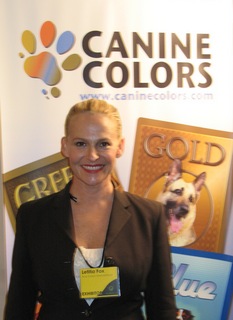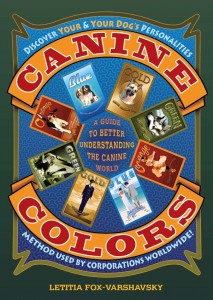Turn your Elevator Pitch into a “Here’s the difference my work makes” story: Letitia Fox of Canine Colors
 I met Letitia Fox, author of Canine Colors http://www.caninecolors.com/ at the Wisdom 2.0 conference in San Francisco. If you’re not aware of True Colors, it’s an extremely useful and fun way of understanding different personality styles and how to best connect and communicate with them.
I met Letitia Fox, author of Canine Colors http://www.caninecolors.com/ at the Wisdom 2.0 conference in San Francisco. If you’re not aware of True Colors, it’s an extremely useful and fun way of understanding different personality styles and how to best connect and communicate with them.
Letitia has taken this model into the canine world as a tool for dog owners and people who work with dogs. Canine Colors helps people understand each dog’s personality and how to best interact and work with them.
In short, it’s a way to help dog owners become more of a “Dog Whisperer”.
I asked Letitia to tell me about her work, which she does in the first part of the video.
I then asked her to tell me a story about the difference Canine Colors has made to a client. She responded by telling me the story in the second part of the video.
Notice the difference in the two presentations.
In the first presentation, you see that Letitia has a dynamic and engaging personality, and is clearly passionate about what she has to offer. Notice it covers the WII-FM—the “What’s in it for me”—right in the beginning, which is very important, and then goes into describing her service delivery model, or the “ how”.
While her enthusiasm is infectious, that presentation alone is not enough. You’re left with a conceptual understanding—a 30,000 foot view—of the value her book and her service provides, but not a more real life, “Oh…I get it” sense of the difference it can make.
This is very common among business people when they give their “elevator pitch”.
 In the second presentation, where she tells the story, notice how your level of engagement shifts. Notice how it’s easier to grasp the benefit of her book and her service. If you don’t have a dog that perplexes you, imagine your response to the story if you WERE a dog owner who loved their dog, but often felt frustrated by the dog’s behavior…and felt guilty about some of the bad feelings you had about your dog because of your frustration. Wouldn’t that story make you want to learn more?
In the second presentation, where she tells the story, notice how your level of engagement shifts. Notice how it’s easier to grasp the benefit of her book and her service. If you don’t have a dog that perplexes you, imagine your response to the story if you WERE a dog owner who loved their dog, but often felt frustrated by the dog’s behavior…and felt guilty about some of the bad feelings you had about your dog because of your frustration. Wouldn’t that story make you want to learn more?
Now… if I were coaching her on how to improve the story, I would make a few recommendations. Keep in mind that she told this story “off the cuff” and despite that did a great job. In contrast, I have the ability to review the tape and deconstruct her story. This is one of the benefits of recording and analyzing your story. I also have 25 years of experience using and teaching storytelling.
So…here are some of the recommendations I would make:
- Name the breed of dog. This makes it easier for the listener to create an image in their mind, which makes it easier for them to relate to the story and remember it, because they can simply “replay the movie.” When telling your stories, you want to include enough sensory detail to help the listener create mental pictures of what you’re talking about.
- Describe the frustrating behaviors the dog was engaging in. Just as with naming the breed of the dog, describing the behaviors makes it easier for the listener to create a picture in their mind of what the problematic behaviors were. Not only does this make it easier for them to “play the movie” it also helps spark the listener’s interest. It helps them recognize “Hey…that’s me she’s talking about”…which is the response you want all of your ideal clients to have when you tell your stories. Describing the behaviors also connect the listener with their own pain around the issue, which would make them even more interested in the solution.
- Describe the lady’s problematic behaviors. Doing this not only achieves the above points already made, it also helps the listener become aware of potentially problematic behaviors they are engaging in, and don’t even realize. This helps increase their motivation to learn more.
- Add a few more descriptions of what the lady did differently after learning about Canine Colors. Notice she did describe a few of the fun activities they did more of—running and hiking. That was great. If there were other behaviors she did that were less controlling and more fun, I would mention those.
- Describe how the relationship has changed. Notice I prompted Letitia to talk about this. I did that because, in what I call the Pain and Promise Story, you want to also describe the “After Picture” of what it’s like after someone benefits from your product or service. It’s sort of like those After Pictures in infomercials where you see the thin guy holding out the waist of his old pants in which you could now fit two or three of him in. (BTW…notice the use of an analogy to explain the “After Picture”).
If I were coaching Letitia, I would ask her to describe how the relationship was enhanced. I would ask her to describe what’s different externally as well as internally.So for instance, an external difference might be “Now… her Golden no longer acts all wired. So for instance…rather than leaping out of reach each time the lady tries to get her to sit, or obey some other command, she follows her commands. She does it because the lady now doesn’t practice commands until AFTER they go for a really brisk walk and short game of fetch.”BTW…notice I said “for instance”. This is an effective way of taking a concept—in this case “no longer acts all wired”–and translates it into a concrete example, so the person doesn’t have to guess what you mean.
Remember I mentioned that I would coach Letitia to talk about what has changed internally with the woman. What I mean by that is how she now feels in situations that had previously frustrated her. Because we are motivated to act by our feelings, you want your story to communicate how your product or service results in different feelings…feelings the person WANTS to have. So for instance, Letitia might say “Now…instead of feeling frustrated with her Golden a lot of the time…and feeling guilty about that…she now feels pure love and complete enjoyment of their time together.”
So those are some of the ways Letitia could take a good story and make it even more compelling.
As you work on your “Here’s how I help people” story, you can use these principles to make your story more fascinating and compelling.
The other key take away message is to CATCH stories. Before you can work on and tweak your stories, you need to collect them.
So…I recommend you make a list of 3-5 of your favorite examples of the difference your book, product, or service has made to your customers, and then tell some people the story of the difference it made in those customer’s lives, and ask them for feedback on how clear and compelling each story was.
Use their feedback to refine or discard each story.
You can also submit your story (if it’s short) for review and if I think it’s a good story to use as a teaching example, I will critique it.
